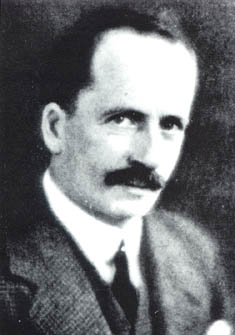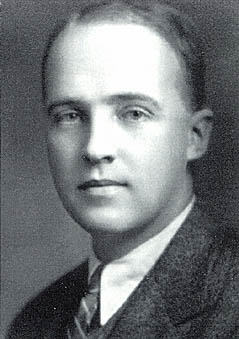INSULIN
Saving
Millions of Lives Worldwide
The Egyptians described
diabetes 4,000 years ago and a Greek physician named the disorder some
2,000 years later, but how to control this devastating condition was unknown
until Frederick G. Banting had an idea that led to the discovery of insulin
in 1921.
 |
In
several magazine polls during his lifetime, Sir Frederick Banting was judged
the most famous living Canadian. Co-discoverers of insulin, Banting and
Professor J.J.R. Macleod of the University of Toronto were co-recipients
of the Nobel Prize for Medicine in 1923. Banting, knighted in 1934, seven
years before he tragically died in an airplane crash, was the first Canadian
to be awarded a Nobel Prize. [The Toronto Star] |
A part-time instructor
at the University of Western Ontario’s medical school, Banting was preparing
a lecture on the pancreas when he read that an American researcher had
tied the pancreatic ducts of animals and found that, although the pancreas
withered, the animals did not develop diabetes. He knew that the pancreas
produces two secretions: one helps the body digest protein, starch and
fat; the other is absorbed directly into the bloodstream. Banting wondered
whether the blockage of the pancreatic ducts had stopped only the digestive
secretions and whether the other secretions, possibly created by the spots
on the pancreas known as the Islets of Langerhans, were still being produced.
At 2:00 a.m. he wrote out his idea: “Ligate pancreatic ducts of dogs. Wait
six or eight weeks. Remove the residue and extract.”
A week later he discussed
his idea with a diabetes expert, Professor J.J.R. Macleod, head of physiology
at the University of Toronto. Macleod was not impressed with Banting’s
idea, asking frankly why he thought he had the answer when others far more
experienced had failed.
Banting nonetheless
persisted. He wrote a more detailed outline, and Macleod finally, in the
spring of 1921, agreed to provide a laboratory. He also gave Banting two
physiology graduate students to take turns doing the analytical work while
he, himself, was vacationing in his native Scotland.
Banting, born on
a farm near Alliston, Ontario, and a University of Toronto medical school
graduate, began his work with Charles Best as his first assistant. The
pancreatic ducts of some dogs were tied and in others removed to create
diabetic animals.
Late in July an operation
on a dog with tied ducts showed a pancreas about one-third normal size.
It was removed and ground in a solution of sand and saline. The extract
was then injected into a diabetic dog near death. The blood sugar decreased
so dramatically that the dog lived weeks longer than expected.
When the other graduate
student was unable to keep the commitment to replace Best, Best remained.
He and Banting worked feverishly over the next two months to confirm their
findings and improve the extract which they called “isletin.”
On returning from
Scotland, Macleod was impressed but insisted they repeat their experiments
to confirm that the results were consistent and that the extract proved
beneficial over time. Also, another means of obtaining enough extract had
to be found, and Banting recommended using the pancreas of unborn calves
obtained from beef cattle at the local abattoir. This proved effective.
Later, the glands of fully grown cows and pigs were used as they are today.
 
|
| Professor
J.J.R. Macleod, left, was a professor of physiology at the University of
Toronto in 1923 when he was awarded the Nobel Prize along with Dr. Banting;
assigned to work as an assistant with Dr. Banting in the spring of 1921,
Charles Best was an integral member of the team discovering insulin. Banting
shared his prize money with Best. Macleod, similarly, shared his prize
money with J.B. Collip. [Dr. Charles Roland; NAC/C-37763] |
Problems still remained.
There was a need to improve the solvent used in the preparation of the
extract in order to reduce its toxicity before it could be tested clinically.
Moreover, if the extract was successful, how to mass produce it would be
important since there were an estimated one million diabetics in North
America.
Macleod, who renamed
the extract “insulin,” enlisted the support of his staff, notably Dr. J.
Bertram Collip, a University of Alberta biochemist then working with him,
to find a less toxic and more effective product. Working with others, particularly
the University of Toronto’s Connaught Laboratories, Collip produced a clinically
acceptable insulin, and in January 1922, Banting was able to administer
it to a patient, 14-year-old Leonard Thompson, whose health improved almost
miraculously. Other diabetics were treated over the next several months
with similar dramatic results.
Diabetes causes excessive
thirst, urination, weight loss, fatigue and eventual emaciation, coma and
death. Treatment with insulin corrects the body’s deficiency of this hormone.
With daily insulin injections, patients recover their normal state; growth
and vigor are regained.
The awesome success
of insulin was first made known in medical journals based on remarks made
by Professor Macleod. Some reports credited him with the discovery, implying
that Banting and Best were assistants. Banting, already feeling that Macleod
had taken over, resented the inference. When the Toronto Daily Star made
the story public in a front-page article in March 1922, a subheading read
“Banting Gives His All on the Result.”
From then on Banting’s
name became synonymous with the discovery. This was later reinforced when
Professor Macleod issued a statement indicating that reports crediting
him with the discovery were wrong and that the idea was entirely Banting’s.
 |
Before
the discovery of insulin in 1921, juvenile diabetes was a dreaded and deadly
disease. Made available in late 1922, insulin, a means of controlling this
more serious form of diabetes, must be injected by syringe on a daily basis.
While not a cure, insulin has saved the lives of millions worldwide. Banting
did not take out a patent on insulin but assigned the rights to the University
of Toronto. [Connaught Laboratories] |
Honours were heaped
on Banting. The University of Toronto made him a full professor of medical
research and later established the Banting Institute in Toronto. Governments
rewarded him with research grants, he was in great demand as a speaker,
numerous medical societies presented him with medals, universities bestowed
honorary degrees, and learned societies made him a member of their organizations.
He was also the first Canadian to win the Nobel Prize (1923). Later he
was knighted.
The fact that the
Nobel Prize was shared with Professor Macleod didn’t please him as he felt
it was Best who deserved this. Consequently, he gave half his prize money
to Best; Macleod split his with Dr. Collip, a move later considered appropriate
when it was realized all four had played a major role in the development
of insulin.
Banting sold the
patent to the University of Toronto for one dollar proposing that Connaught
Laboratories produce the extract. They did, but the demand was so great
that Eli Lilly Company (Canada) Limited, which had worked on the purification
of the insulin in 1922, was awarded a contract and produced the first commercial
supply in 1923. This company is today a major producer of insulin.
In 1928 Dr. Macleod
returned to work in Scotland. Dr. Collip was later Dean of the University
of Western Ontario’s medical school and Charles Best, graduating in medicine
in 1925, served as chairman of the University of Toronto’s physiology department
from 1929 to 1965. Dr. Banting continued to do research but also spent
much of his time encouraging young scientists with their discoveries.
At the outbreak of
World War II, Banting succeeded in assisting an RCAF doctor, W.R. Franks,
to develop the world’s first anti-G suit designed to prevent pilots from
blacking out. Asked to conduct research on seasickness, Banting boarded
a bomber flying to England but, tragically, died of a punctured lung when
the plane crash-landed near Musgrave Harbour, Newfoundland, in February
1941.



